Related Research Articles

Mahavir Janma Kalyanak is one of the most important religious festivals in Jainism. It celebrates the birth of Mahavira, the twenty-fourth and last Tirthankara of present Avasarpiṇī. On the Gregorian calendar, the holiday occurs either in March or April.

The Dilwara Temples or Delvada Temples are a group of Śvētāmbara Jain temples located about 2+1⁄2 kilometres from the Mount Abu settlement in Sirohi District, Rajasthan's only hill station. The earliest were built by Bhima I and supposedly designed or at least financed by Vastupala, Jain minister of Dholka. They date between the 11th and 16th centuries, forming some of the most famous monuments in the style of Māru-Gurjara architecture, famous for their use of a very pure white marble and intricate marble carvings. They are managed by Seth Shri Kalyanji Anandji Pedhi, Sirohi and are a pilgrimage place for Jains, and a significant general tourist attraction. The Dilwara temples are regarded as the most impressive among Jain temples in Rajasthan.

Ranakpur is a village located in Desuri tehsil near Sadri town in the Pali district of Rajasthan in western India. It is located between Jodhpur and Udaipur, 162 km from Jodhpur and 91 km from Udaipur, in a valley on the western side of the Aravalli Range. The nearest railway station to reach Ranakpur is Falna and Rani railway station. Ranakpur is easily accessed by road from Udaipur, Pali district in Rajasthan. Ranakpur is one of the most famous places to visit in Pali, Rajasthan and is widely known for its marble Jain temple, said to be the most spectacular of the Jain temples.

Rajasthan, a state in western India, has had a close historical connection with Jainism. Southwestern Rajasthan was the main centre for Śvetāmbara Jainism. Major Digambara centres are in the northern and eastern parts of Rajasthan. Central and Northern Rajasthan are the main centres for the Terapanth sect of Śvetāmbara Jainism.
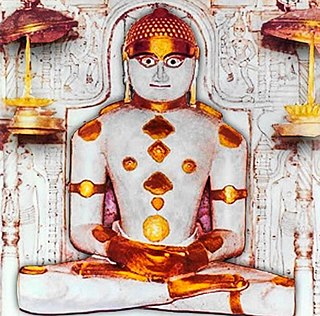
Rishabhanatha, also Rishabhadeva, Rishabha or Ikshvaku, is the first tirthankara of Jainism. He was the first of twenty-four teachers in the present half-cycle of time in Jain cosmology, and called a "ford maker" because his teachings helped one cross the sea of interminable rebirths and deaths. The legends depict him as having lived millions of years ago. He was the spiritual successor of Sampratti Bhagwan, the last Tirthankara of previous time cycle. He is also known as Ādinātha, as well as Adishvara, Yugadideva, Prathamarajeshwara and Nabheya. He is also known as Ikshvaku, establisher of the Ikshvaku dynasty. Along with Mahavira, Parshvanath, Neminath, and Shantinath, Rishabhanatha is one of the five Tirthankaras that attract the most devotional worship among the Jains.

A Jain temple, Derasar or Basadi is the place of worship for Jains, the followers of Jainism. Jain architecture is essentially restricted to temples and monasteries, and Jain buildings generally reflect the prevailing style of the place and time they were built.
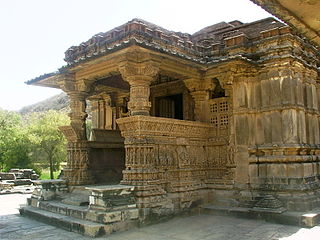
The architecture of the Indian state of Rajasthan has usually been a regional variant of the style of Indian architecture prevailing in north India at the time. Rajasthan is especially notable for the forts and palaces of the many Rajput rulers, which are popular tourist attractions.
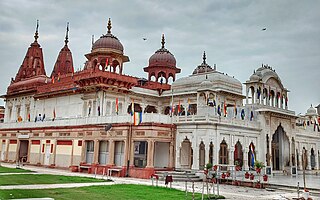
Shri Mahavir Ji is an important and prominent Jain pilgrimage site situated in Shri Mahaveerji town in Hindaun Block, Karauli district in Rajasthan. Given the importance of the religious place, the Indian Railways has specifically developed a railway station under West Central Railway zone by the name of Shri Mahaveerji railway station which is 10 minutes drive from the temple and temple authorities have arranged for regular buses from the station to the temple. The temple is visited by millions of Jain and Hindu devotees every year.
Ghanerao is a village in Desuri tehsil of Pali district of Rajasthan.
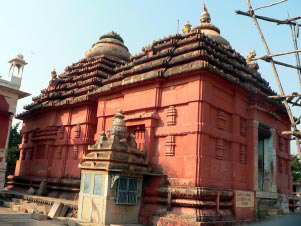
Digambara Jaina Temple is a Jain temple in Bhubaneswar, in the state of Odisha, India. The temple is on the top of Khandagiri hill. This hill is honeycombed with a series of rock-cut Jaina caves, commissioned by King Kharavela in the 1st century BCE. The rock-cut caves are protected by Archaeological Survey of India. The enshrining deities are a series of Jaina tirthankara images.

Hutheesing Temple is a Jain temple in Ahmedabad in Gujarat, India. It was constructed in 1848 by the Hutheesing family. The temple blends the old Maru-Gurjara temple architecture style with new architectural elements of haveli in its design.

Ranakpur Jain temple or Chaturmukha Dharana Vihara is a Śvētāmbara Jain temple at Ranakpur dedicated to Tirthankara Rishabhanatha. The temple is located in a village of Ranakpur near Sadri town in the Pali district of Rajasthan.
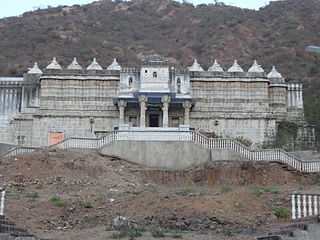
Mirpur Jain Temple is situated in Mirpur, a fortified village in the Sirohi district of Rajasthan, India. The village has four Jain temples.

Shri Mahaveer Ji is a town and tehsil headquarter in Hindaun Block, Karauli District, Rajasthan. Approximately 20,000 people live there, and Many villages come within its area. A hydrological station is installed at the town.
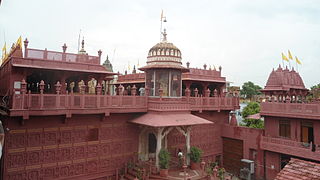
Shri Digamber Jain Atishya Kshetra Mandir, Sanghiji is an ancient Jain Temple in Sanganer, Rajasthan made of red stone. The ancient Shri Digamber Jain temple of Sanganer is 16 km from Jaipur.

Jainism in Bihar trace a long history since the times of twenty-fourth Tirthankara Mahavira, who was born in Vaishali. The state of Bihar is considered to have played an important role in the development of Jainism.
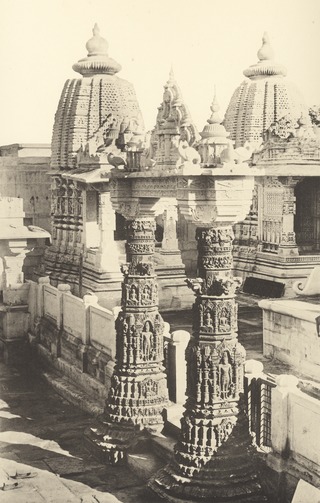
The Mahavira Jain temple is built in Osian of Jodhpur District, Rajasthan. The temple is an important pilgrimage of the Oswal Jain community. This temple is the oldest surviving Jain temple in Western India and was built during the reign of Mahārāja Śrī Vatsarāja of Imperial Pratihāras. The temple is visited by both Jain and Hindu.
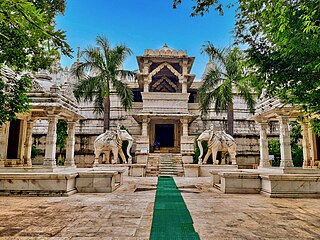
The Kumbharia Jain temples is a group of five Jain temples in the Kumbhariya, Banaskantha district in Gujarat, India. Constructed from 1062 to 1231 CE during the reign of the Chaulukya dynasty, they are noted for their elaborate architecture.
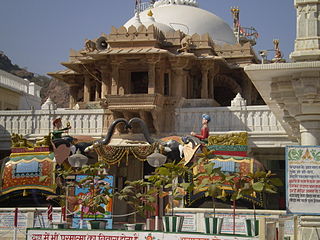
Nakodaji Tirth is a major Jain tirth in the Indian state of Rajasthan, located between the villages of Vikrampura and Nakoda in Barmer District. The temple houses the icon of Nakoda Bhairava, a popular Shvetambara guardian deity.

Kesariyaji Tirth or Rishabhdeo Jain temple is a Jain temple located in Rishabhdeo town of Udaipur District of Indian state of Rajasthan. The temple is considered an important pilgrimage center by both Digambara and Śvētāmbara sect of Jainism.
References
Citation
Source
- Das, Joydip (2014). Royal Rajasthan Pocket Travel Guide. Bluworlds Guides.
- Mehta, Jodh Sinha (1970). Abu to Udaipur (Celestial Simla to City of Sunrise). Motilal Banarsidass.
- IGNCA. "Shree Muchhal Mahavir Ji Mandir" (PDF). Indira Gandhi National Centre for the Arts.